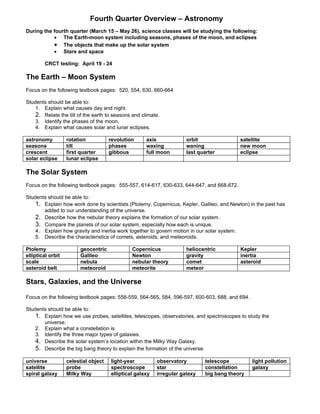
Es 4th Quarter Overview 09 10
- 1. Fourth Quarter Overview – Astronomy During the fourth quarter (March 15 – May 26), science classes will be studying the following: • The Earth-moon system including seasons, phases of the moon, and eclipses • The objects that make up the solar system • Stars and space CRCT testing: April 19 - 24 The Earth – Moon System Focus on the following textbook pages: 520, 554, 630, 660-664 Students should be able to: 1. Explain what causes day and night. 2. Relate the tilt of the earth to seasons and climate. 3. Identify the phases of the moon. 4. Explain what causes solar and lunar eclipses. astronomy rotation revolution axis orbit satellite seasons tilt phases waxing waning new moon crescent first quarter gibbous full moon last quarter eclipse solar eclipse lunar eclipse The Solar System Focus on the following textbook pages: 555-557, 614-617, 630-633, 644-647, and 668-672. Students should be able to: 1. Explain how work done by scientists (Ptolemy, Copernicus, Kepler, Galileo, and Newton) in the past has added to our understanding of the universe. 2. Describe how the nebular theory explains the formation of our solar system. 3. Compare the planets of our solar system, especially how each is unique. 4. Explain how gravity and inertia work together to govern motion in our solar system. 5. Describe the characteristics of comets, asteroids, and meteoroids. Ptolemy geocentric Copernicus heliocentric Kepler elliptical orbit Galileo Newton gravity inertia scale nebula nebular theory comet asteroid asteroid belt meteoroid meteorite meteor Stars, Galaxies, and the Universe Focus on the following textbook pages: 558-559, 564-565, 584, 596-597, 600-603, 688, and 694. Students should be able to: 1. Explain how we use probes, satellites, telescopes, observatories, and spectroscopes to study the universe. 2. Explain what a constellation is. 3. Identify the three major types of galaxies. 4. Describe the solar system’s location within the Milky Way Galaxy. 5. Describe the big bang theory to explain the formation of the universe. universe celestial object light-year observatory telescope light pollution satellite probe spectroscope star constellation galaxy spiral galaxy Milky Way elliptical galaxy irregular galaxy big bang theory